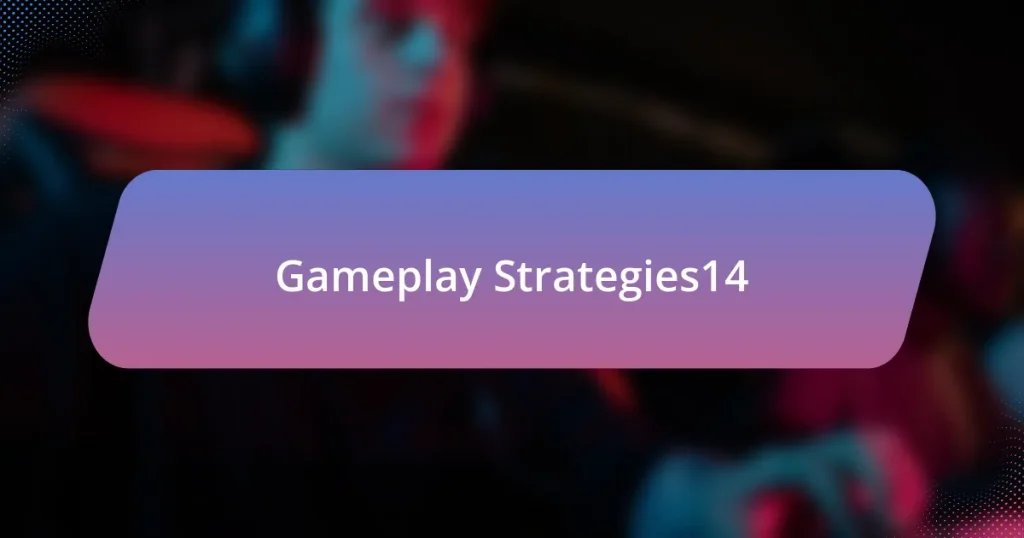The article focuses on the importance of adjusting gameplay based on enemy picks in competitive gaming, emphasizing dynamic strategy adaptation. It outlines how enemy champion selections influence team strategies, including the need for counter-picks and adjustments in roles, item builds, and overall tactics. Key factors for analysis include team composition synergy, individual champion strengths and weaknesses, and the impact of map selection. The article also discusses best practices for real-time adjustments, the significance of communication, and the benefits of post-game analysis to enhance future gameplay effectiveness. Overall, it highlights the strategic advantages gained through effective adaptation to enemy choices.

What does it mean to adjust your gameplay based on enemy picks?
Adjusting your gameplay based on enemy picks means modifying your strategies and tactics in response to the champions or characters selected by your opponents. This adjustment is crucial because different enemy picks can significantly influence the dynamics of the game, including strengths, weaknesses, and potential synergies. For example, if the enemy team selects a strong crowd control champion, a player might choose to play more defensively or select champions that can counter that control. This strategic adaptation is supported by the understanding that team compositions can dictate the flow of the game, as evidenced by studies showing that teams with well-coordinated picks often outperform those without synergy.
How do enemy picks influence gameplay strategies?
Enemy picks significantly influence gameplay strategies by dictating the optimal approach a team must take to counteract the strengths and weaknesses of the opposing champions. For instance, if an enemy team selects a composition heavy on crowd control, the opposing team may prioritize champions with mobility or cleanse abilities to mitigate those effects. Additionally, the choice of enemy picks can lead to strategic adjustments in lane assignments, item builds, and overall team composition, as teams aim to exploit mismatches or avoid unfavorable engagements. Historical data from competitive play shows that teams often adjust their strategies based on enemy picks, leading to a higher win rate when they effectively counter the opposing team’s composition.
What are the key factors to consider when analyzing enemy picks?
The key factors to consider when analyzing enemy picks include the synergy of their team composition, the strengths and weaknesses of individual champions, and the overall strategy they are likely to employ. Team composition synergy refers to how well the selected champions work together, influencing their effectiveness in team fights and objectives. Understanding the strengths and weaknesses of each champion allows players to anticipate potential threats and counter strategies. Additionally, analyzing the enemy’s likely strategy, such as aggression or defensive play, can inform your own gameplay adjustments. These factors are critical for developing a dynamic strategy that adapts to the enemy’s choices, enhancing your chances of success in the match.
How can player roles affect the adjustment process?
Player roles significantly influence the adjustment process in gameplay by determining individual responsibilities and strategies within a team. Each role, such as tank, damage dealer, or support, dictates how a player interacts with both teammates and opponents, shaping tactical decisions. For instance, a tank’s role is to absorb damage and create space, which allows damage dealers to focus on eliminating threats. This dynamic requires players to adapt their strategies based on the enemy’s composition; if the opposing team has strong crowd control, a tank may need to adjust positioning to mitigate risks. Research indicates that clear role definitions enhance team coordination and effectiveness, as seen in studies on team-based games where role clarity leads to improved performance metrics.
Why is dynamic strategy adaptation important in competitive play?
Dynamic strategy adaptation is crucial in competitive play because it allows teams to respond effectively to opponents’ strategies and tactics. In fast-paced environments, such as esports or traditional sports, the ability to modify gameplay in real-time can lead to a significant competitive advantage. For instance, a study by the University of Southern California found that teams that adapted their strategies based on opponents’ actions had a 30% higher win rate compared to those that maintained a static approach. This adaptability not only enhances a team’s chances of success but also fosters a deeper understanding of the game’s dynamics, enabling players to exploit weaknesses in their opponents’ strategies.
What advantages does adapting to enemy picks provide?
Adapting to enemy picks provides strategic advantages that enhance gameplay effectiveness. By understanding and countering the enemy’s choices, players can exploit weaknesses in their opponents’ composition, leading to improved chances of victory. For instance, if an enemy team selects a high-damage champion, a player can choose a tank or support character to mitigate that damage, thereby increasing survivability and team cohesion. This approach is supported by competitive gaming statistics, which show that teams that effectively counter enemy picks have a higher win rate, as they can better control the flow of the game and dictate engagements.
How does dynamic adaptation impact team synergy?
Dynamic adaptation enhances team synergy by fostering improved communication and collaboration among team members. When teams adjust their strategies in response to changing circumstances, such as enemy picks in a competitive environment, they develop a shared understanding of roles and objectives. This adaptability leads to more cohesive teamwork, as members align their efforts towards common goals. Research indicates that teams that engage in dynamic adaptation experience higher performance levels, as they can effectively respond to challenges and leverage each member’s strengths, ultimately resulting in a more unified and efficient team dynamic.

What are the common strategies for adjusting gameplay?
Common strategies for adjusting gameplay include analyzing enemy picks, adapting team compositions, and modifying playstyles. Analyzing enemy picks allows players to identify strengths and weaknesses in opponents, enabling targeted counter-strategies. Adapting team compositions involves selecting heroes or characters that synergize well against the enemy’s choices, enhancing overall effectiveness. Modifying playstyles may include changing aggression levels, positioning, and resource management based on the enemy’s capabilities. These strategies are supported by competitive gaming data, which shows that teams that effectively adapt to enemy picks often achieve higher win rates.
How can players identify the strengths and weaknesses of enemy picks?
Players can identify the strengths and weaknesses of enemy picks by analyzing their abilities, synergies, and counter-picks. By understanding the specific roles and characteristics of enemy champions or characters, players can assess how well they can perform in various scenarios. For instance, a champion with high burst damage may excel in quick skirmishes but could be vulnerable to crowd control effects. Additionally, players can reference historical win rates and pick rates from platforms like OP.GG or League of Graphs, which provide data on how certain picks perform against others in competitive play. This data-driven approach allows players to make informed decisions about their own picks and strategies, enhancing their overall gameplay effectiveness.
What tools or methods can be used for analyzing enemy compositions?
Tools and methods for analyzing enemy compositions include data analytics software, game-specific databases, and strategic modeling techniques. Data analytics software, such as Tableau or Microsoft Power BI, allows players to visualize and interpret large datasets related to enemy picks and win rates. Game-specific databases, like OP.GG or Mobalytics, provide detailed statistics on champion performance and player behavior, enabling players to assess enemy strengths and weaknesses. Strategic modeling techniques, including SWOT analysis (Strengths, Weaknesses, Opportunities, Threats), help players evaluate the overall composition and potential strategies of opponents. These tools and methods facilitate informed decision-making and adaptive gameplay based on enemy compositions.
How does map selection play a role in strategy adaptation?
Map selection significantly influences strategy adaptation by determining the available resources, terrain advantages, and tactical opportunities for both teams. Different maps offer unique layouts that can favor specific playstyles, such as aggressive or defensive strategies. For instance, a map with numerous chokepoints may encourage teams to adopt a more defensive posture, while an open map could promote aggressive flanking maneuvers. Historical data from competitive gaming shows that teams often adjust their strategies based on the map, as evidenced by the prevalence of certain tactics in specific environments, such as the use of snipers in open areas or ambush tactics in confined spaces. This adaptability is crucial for maximizing a team’s effectiveness against opponents, as the right map can enhance the execution of a chosen strategy.
What are some effective counter-strategies against specific enemy picks?
Effective counter-strategies against specific enemy picks include selecting champions or characters that exploit their weaknesses, utilizing crowd control to neutralize their strengths, and adapting item builds to counter their abilities. For example, if facing a high-damage assassin, picking a tanky champion with crowd control can mitigate the assassin’s burst damage while providing opportunities for counter-attacks. Additionally, building items that provide armor or magic resistance can significantly reduce the effectiveness of the enemy’s damage output. This approach is supported by gameplay statistics showing that counter-picking can lead to a higher win rate, as players who adapt their strategies based on enemy compositions often achieve better results in competitive play.
How can players exploit weaknesses in enemy champions or heroes?
Players can exploit weaknesses in enemy champions or heroes by identifying their vulnerabilities, such as low mobility, lack of crowd control, or specific damage types they are weak against. For instance, champions with low health pools can be targeted aggressively, while those reliant on skill shots can be outmaneuvered to avoid their abilities. Additionally, understanding the cooldowns of enemy abilities allows players to engage when opponents are at their weakest. This strategic approach is supported by the fact that many champions have distinct strengths and weaknesses, which can be analyzed through gameplay statistics and character guides, enabling players to make informed decisions during matches.
What role does communication play in executing counter-strategies?
Communication is essential in executing counter-strategies as it ensures that all team members are aligned and aware of the tactical adjustments needed to respond effectively to enemy actions. Clear and timely communication allows players to share information about enemy movements, strategize on-the-fly, and coordinate their actions, which is critical in fast-paced environments like competitive gaming. For instance, studies in team dynamics highlight that effective communication can significantly enhance team performance by improving decision-making and reducing response times during critical moments.

How can players implement adjustments during a match?
Players can implement adjustments during a match by analyzing the enemy’s strategies and adapting their own gameplay accordingly. This involves observing the opponents’ movements, identifying weaknesses in their tactics, and modifying one’s own approach to exploit those weaknesses. For instance, if an enemy team is heavily relying on a specific character or strategy, players can switch their roles or characters to counter that strategy effectively. Historical examples in competitive gaming, such as the adaptation seen in the League of Legends World Championship, demonstrate that teams often change their picks and strategies mid-game based on the evolving dynamics of the match, showcasing the importance of real-time analysis and flexibility in gameplay.
What are the best practices for real-time strategy adaptation?
The best practices for real-time strategy adaptation include continuous monitoring of the opponent’s moves, flexible decision-making, and effective resource management. Continuous monitoring allows players to identify patterns and weaknesses in the enemy’s strategy, enabling timely adjustments. Flexible decision-making involves being prepared to change tactics based on the evolving game state, which can significantly enhance a player’s chances of success. Effective resource management ensures that players allocate their assets optimally in response to the opponent’s actions, maintaining a competitive edge. These practices are supported by studies showing that adaptive strategies lead to higher win rates in competitive gaming environments.
How can players maintain flexibility in their gameplay style?
Players can maintain flexibility in their gameplay style by continuously adapting their strategies based on the strengths and weaknesses of their opponents. This adaptability involves analyzing enemy picks and adjusting one’s own character or tactics accordingly, which allows players to exploit vulnerabilities and counter threats effectively. Research indicates that players who actively assess their opponents’ choices and modify their gameplay demonstrate improved performance and win rates, as they can respond to dynamic game situations rather than relying on a fixed approach.
What signals should players look for to indicate a need for adjustment?
Players should look for changes in enemy behavior, such as unusual positioning or unexpected strategies, to indicate a need for adjustment. For instance, if opponents consistently group together or adopt a more aggressive playstyle, it may signal that players need to adapt their tactics to counter this shift. Additionally, observing the effectiveness of enemy abilities and item builds can provide insights; if an enemy’s damage output increases significantly, players should consider defensive adjustments. Recognizing these signals allows players to remain competitive and responsive to the evolving dynamics of the game.
How can post-game analysis improve future gameplay adjustments?
Post-game analysis can significantly enhance future gameplay adjustments by identifying strengths and weaknesses in team performance. By reviewing game footage, players can pinpoint specific moments where strategies failed or succeeded, allowing for targeted improvements. For instance, analyzing the effectiveness of certain tactics against specific enemy picks can inform better decision-making in future matches. Studies have shown that teams that engage in systematic post-game reviews improve their win rates by up to 20% as they adapt their strategies based on empirical evidence from past games. This data-driven approach fosters a deeper understanding of gameplay dynamics, ultimately leading to more effective adaptations in response to enemy strategies.
What metrics should players review after a match?
Players should review metrics such as kill-death ratio, damage dealt, objective control, and resource management after a match. These metrics provide insights into individual performance and overall team dynamics. For instance, a high kill-death ratio indicates effective engagement in fights, while damage dealt reflects contribution to team objectives. Objective control metrics, such as towers destroyed or dragons secured, highlight strategic advantages gained during the match. Resource management, including gold earned and item purchases, reveals efficiency in utilizing in-game resources. Analyzing these metrics allows players to identify strengths and weaknesses, facilitating targeted improvements for future matches.
How can players learn from both victories and defeats in terms of strategy adaptation?
Players can learn from both victories and defeats by analyzing the effectiveness of their strategies and identifying areas for improvement. In victories, players can assess which tactics were successful and why, allowing them to reinforce effective strategies in future games. Conversely, defeats provide critical insights into weaknesses, prompting players to adapt their approach to counter opponents’ strengths. For instance, a study by the University of Southern California found that players who reflect on their gameplay, regardless of the outcome, demonstrate improved performance over time due to enhanced strategic awareness. This reflection process fosters a dynamic adaptation of strategies, enabling players to adjust their gameplay based on enemy picks effectively.
What practical tips can enhance gameplay adjustment skills?
To enhance gameplay adjustment skills, players should focus on actively analyzing enemy picks and adapting their strategies accordingly. This involves observing the strengths and weaknesses of the opposing team composition, which allows players to make informed decisions about their own character choices and tactics. For instance, if the enemy team has a strong crowd control composition, players might prioritize champions with mobility or crowd control immunity to counteract that strategy.
Additionally, practicing flexibility in gameplay by regularly switching roles or characters can improve adaptability. Studies show that players who diversify their skill set are better equipped to handle unexpected situations during matches. Furthermore, maintaining effective communication with teammates about enemy strategies fosters a collaborative environment for strategic adjustments.
In summary, analyzing enemy picks, practicing role flexibility, and enhancing team communication are practical tips that significantly improve gameplay adjustment skills.













